Where: The photographer was up on Hospital Road, looking north-east across Tai Ping Shan to the harbour, and Tsim Sha Tsui beyond. Here's a copy marked up with some of the roads in the area (click the photo for a larger copy you can zoom in to):
What: Most of the area is densely-packed housing, but there are a few larger buildings and landmarks we can identify. The best group is down in the bottom-left corner:
The open area at the top is marked "Possession Point" on an 1889 map [1]. It's still an open area today, now called Hollywood Road Park.
Just south across Hollywood Road there's a church on the corner of Po Yan Street. It's the original St Stephen's church in Hong Kong [2], founded here in the 1860s.
South again across New Street is the compound of the Tung Wah Hospital [3], with several grand buildings there. To the right across Po Yan Street is a building under construction. When it is finished, it will be an extension to the Tung Wah Hospital.
Up on the seafront, this building with its larger windows stands out as something different from its neighbours.
It was a government building, the Harbour Master's office [4].
Following the shoreline along to the right, there's a ship docked at a pier:
That 1889 map shows it joined the Praya (today's Des Voeux Road) roughly where the junction with Man Wa Lane is today. However it doesn't note the name of the pier or the shipping company that used it - can anyone identify it?
When: We'll look across the harbour for clues.
The building is the old Marine Police Headquarters [5] in TST. The building was finished in 1884, so the photo can't be older than that. And it looks as though the time ball is visible on top of the round tower to the right. That went into service in 1885, so we're looking at 1885 or later for this photo.
Another 1880s photo in my collection [6] also shows the TST shoreline. Here's a comparison:
The upper photo looks newer, as it shows an extra pier at the Kowloon Wharves, and additional development underway in front of the Marine Police HQ.
We know that the upper photo can't have been taken later than 1888, as it shows the Roman Catholic Cathedral (finished in 1888) is still under construction. That narrows down the date range for this photo to 1885-1888.
I'd provisionally dated the newer photo to 1886, which would narrow down the dates for the present photo even further to 1885-6. However, another source suggests 1887, based on the Tung Wah extension that's under construction. Mr Cheng Po Hung comments [7]:
that the location of the Tung Wah Hospital expansion, which was under construction in the photo, was ((previously)) a cinema ((probably a theatre)).The cinema was burnt in c1885. The Tung Wah Hospital then acquired that land and built the new hospital. so the date of this photo should be around 1887.
A search for "Tung Wah" in the newspapers didn't turn up any mentions of this extension, so I haven't been able to confirm the date. I'll stick with early 1886 as my guess for this photo's date, but corrections are welcome.
Who: The only people we can see are the bricklayers, hard at work on the Tung Wah extension:
Here they're working on straight walls, but we can also see they wooden forms they've made to help them build neat brick arches:
Trivia: Here's how the photo looked before restoration:
That line sweeping down across the photo looks like a bad scratch, but in fact there isn't any damage to the photo's surface. Instead it was caused by a crack in the glass plate negative. The crack hadn't completely broken the plate in two yet, so the photographer was still using it to make prints for sale. But you'd wonder how many customers would buy the photo with a line across it like this.
From the other photos it was sold with, I guess that the original owner bought it around 1900. The glass plate was already over 10 years old, and coming to the end of its life.
References:
- "(1889) The City of Victoria", Plate 3-2, Mapping Hong Kong
- St Stephen's Church
- Tung Wah Hospital
- Harbour Master's Office
- Marine Police Headquarters
- c.1886 View over Central and the Harbour
- Mr Cheng's comments: http://gwulo.com/node/5132#comment-11166
Reference: A254
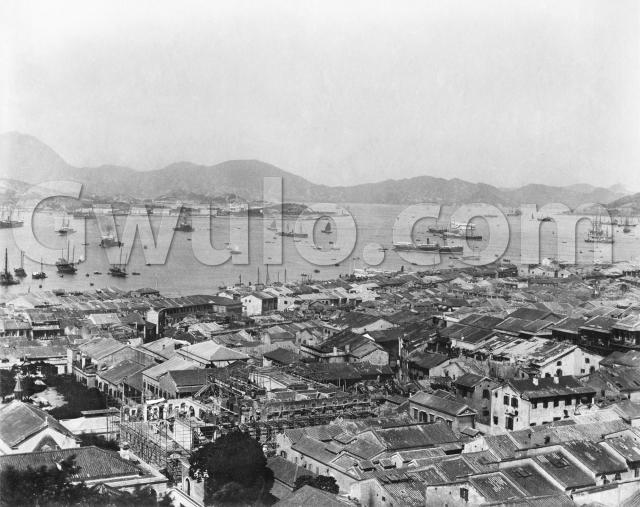
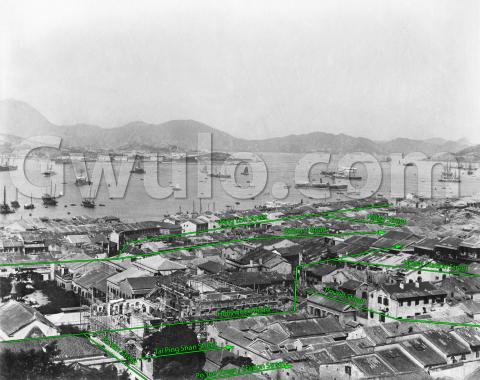
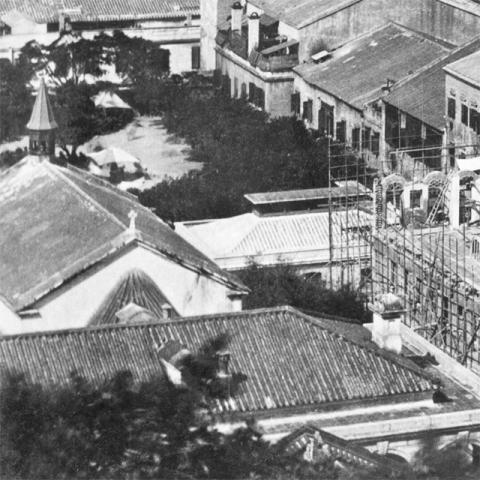
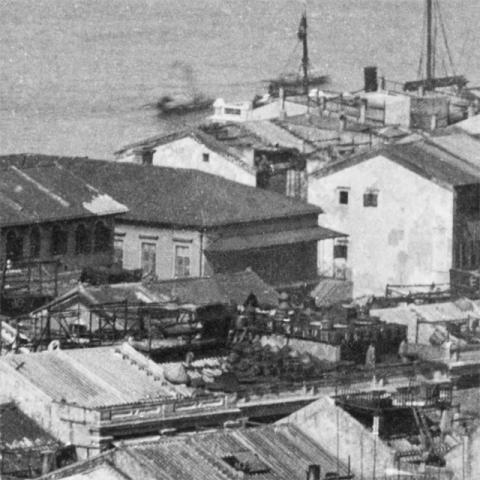
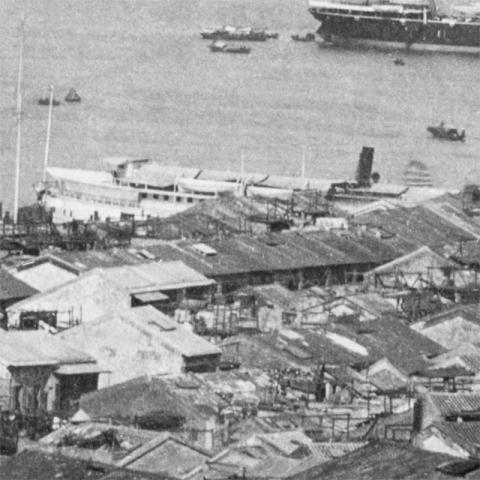
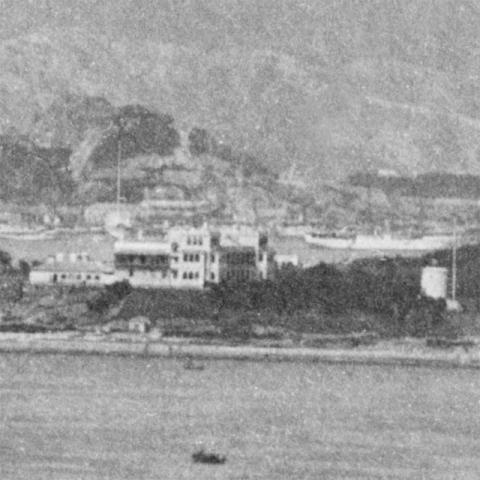
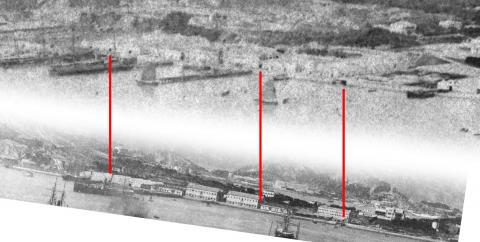
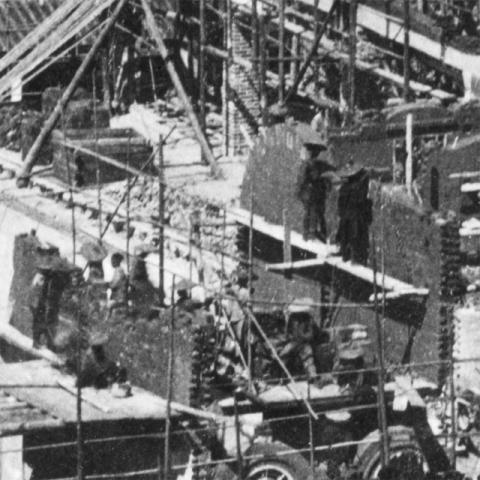
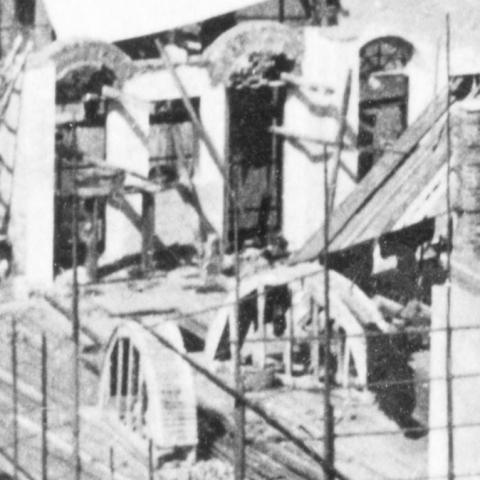
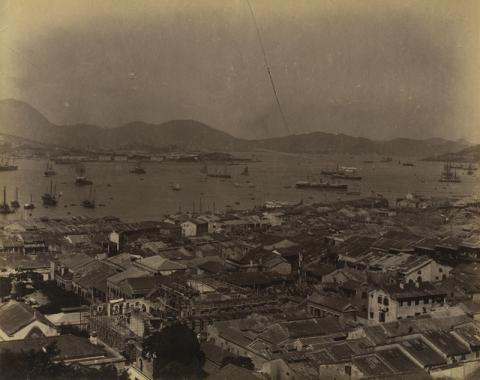

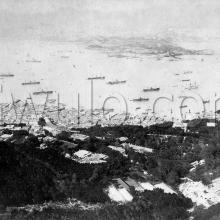
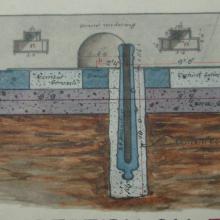
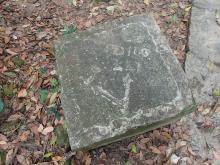
Comments
Golden Jubilee Fountain in 1887
I recall one of the Golden Jubilee Fountains was erected at Possession Point in 1887. Difficult to detect from the photo, though.
re: fountains
details of the jubilee fountains and their locations here: http://www.flickr.com/photos/76716456@N06/8745535340/
re: fountains
That's a good idea. I looked closely at the original photo, but can't see any sign of a fountain. And unfortunately there's not enough of the park showing to be sure we'd see it if it was already there when the photo was taken.
Regards, David
Re: Style of houses
Hi there,
Interesting photo. I believe we could spot traditional Chinese style houses and tell them apart from Western style ones, as well as those looked somewhere in between, by one distingished characteristic: Chimneys.
Most traditional Chinese houses, especially village houses, does not have a visible chimney. Usually it is just a square hole on the roof or on the side wall. I do not know Fung Shui, but I have an old friend actively expanding in this field. He would try to lecture me (or any other person at ear's length, which I always failed to comprehend) about a visible chimney or a spire or even a flag post from your window or your door is bad Fung Shui.
I have also been told (and afirmed) that the Brits actually believed in Fung Shui. The collection of ancient Fung Shui reference books in the British Museum (or Library or both) in London is a breath taking one.
My 2 cents,
T
1880 Same View
There is a photo of the same scene in the Hong Kong Public Library system dated 1880. Possession Point park is shown but without any trees.
https://mmis.hkpl.gov.hk/coverpage/-/coverpage/view?_coverpage_WAR_mmisp...
If the link doesn't work, you can search for the Bib ID which is PH64.355
Tung Wah Hospital Extension Site
The site of the new extension of the Tung Wah Hospital was previously the Pok Lok theatre, owned by Ying Kit of Nam Pak Hong. The theatre was destroyed in a fire on 02-02-1886, according to the China mail:
This afternoon a serious conflagration took place in the Pok Lok Chinese theatre in Hollywood Road, resulting in the complete destruction of the interior of the building and probably necessitating the pulling down of the greater portion if not the whole of the walls, and unfortunately, attended by loss of life.
Full article here (bottom of page 3 first column) https://mmis.hkpl.gov.hk/coverpage/-/coverpage/view?_coverpage_WAR_mmisp...
The fire was caused by a woman knocking over a Kerosene lamp that she was cleaning. Two children, a girl Kung Chi Hai aged 5, and another girl, Wo Kung Knk aged 9 died in the fire at the theatre, which was closed in preparation for a grand play on Chinese New Year's day. The inquest into their deaths is reported in the China Mail dated 03-03-1886 (page 3, column 3)
By the date of the fire and the progress of construction for the new hospital wing, I think the photo should be dated to 1887 rather than 1886.
Another article I found gives a good description of some of the other theatres in the area as well as the government attempts to stamp out prostitution that the district was notorious for:
http://experimentalethnography.net/1930s/?portfolio=queen%E2%80%99s-road...
Tung Hing Theatre
The first purpose built theatre in HK, Tung Hing theatre, was built on the corner of market Street (today named Po-Hing Fong) and Grace street (today called Po Yan Street) This theatre opened in 1867, and was later renamed Chung Hing Yuen. The theatre closed in early 1910. The Duke of Edinburgh visited in 1869 to see a Chinese Opera performance put on in his honour by the local Chinese community.
A photo of this theatre in the 1870's can be seen on page 25 of the Heritage Impact Assesment of the Ya Ma Tei theatre dated Oct 2008: http://www.amo.gov.hk/form/YMTT_RBB_HIA%20Report.pdf
Another famous theatre in the district was the Ko Shang theatre on Queens Road West. It opened in 1890 and closed in 1973
http://www.amo.gov.hk/en/trails_sheungwan1.php?tid=31
https://mmis.hkpl.gov.hk/coverpage/-/coverpage/view?_coverpage_WAR_mmisp...
1887
Good detective work, thank you. I agree that 1887 is a more likely date for the photo.
If you are adding information about buildings, I recommend you make a "Place" page for them, eg here's a Place page for the Pok Lok Theatre:
http://gwulo.com/node/19760
Regards, David
Temple?
I just read a description of that area written by a german missionary in 1880. Looking down the hill he locates Tung Wah Hospital and St. Stephen´s Church to the left. And opposite the theatre and a temple.
Does anyone know the name of that temple? That temple must be very old as the missionary described it on his first stay in Kong Kong in 1855. And does it still exist?
Behind the temple he mentions a Chinese Smallpox Hospital in 1880.
There were a number of
There were a number of temples in the area but from the description it sounds like he is describing the Kwong Fuk Ancestral Hall/Pak Sing Temple which was built in 1851 and still exists today. You can see its roof in the above photo just to the right of the hospital building under construction. Today the temple is located on Tai Ping Shan Street
Information on the Jubilee Fountains
Information on the jubilee fountains can be viewed here and here